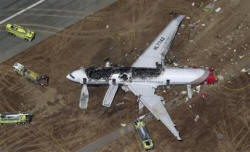|
 Slow
Speed, Faulty Warning System Blamed In Fatal Asiana Plane Crash Slow
Speed, Faulty Warning System Blamed In Fatal Asiana Plane Crash
 Send a link to a friend
Send a link to a friend
[April 01, 2014]
By Carey Gillam
(Reuters) — The Asiana Airlines Inc flight
that crashed in San Francisco in July, killing three passengers, was
likely because the pilots were flying dangerously slow and a warning
system that should have alerted them was inadequate, according to
conclusions drawn by the airline and reported in documents released by
U.S. investigators on Monday.
|
|
 "The probable cause of this accident was the flight crew's failure
to monitor and maintain a minimum safe airspeed during a final
approach," Asiana Airlines said in its report to the National
Transportation Safety Board (NTSB). "The probable cause of this accident was the flight crew's failure
to monitor and maintain a minimum safe airspeed during a final
approach," Asiana Airlines said in its report to the National
Transportation Safety Board (NTSB).
The airline also blamed what it called "inadequate warning systems"
for alerting the flight crew that the auto-throttle had stopped
maintaining the set airspeed. It suggested the aircraft
manufacturer, Boeing Co, modify the low-speed alert system on its
planes.
Immediately after the July 6, 2013 crash, Asiana said there appeared
to be no mechanical problem with the aircraft. But in its latest
document the airline blamed the design of the auto-throttle, an
issue that had been raised previously.

For its part, Boeing said in its submission to the NTSB that "there
were numerous cues" that the aircraft's speed was slowing
dangerously and it placed the blame for the crash squarely on the
pilots.
"This accident occurred due to the flight crew's failure to monitor
and control airspeed, thrust level and glide path on short final
approach," Boeing said. "This accident would have been avoided had
the flight crew followed procedures and initiated a timely go-around
as the approach became increasingly unstable..."
The crash killed three people and injured more than 180 and was the
first fatal commercial airplane crash in the United States since
February 2009. The co-pilot, who was training the pilot flying the
plane, thought the auto-throttle on the Boeing 777 jet might not
have been operating, the documents showed.
[to top of second column] |

The pilot flying the plane said he wasn't sure whether the
auto-throttle was maintaining speed, according to the documents.
The low, slow landing caused the plane's tail to hit a seawall short
of the runway. The plane spun 330 degrees as it broke apart and
caught fire, strewing wreckage along the runway.
The NTSB opened an investigative hearing into the causes of the
crash in December and has been examining concerns about the
auto-throttle.
(By Carey Gillam; additional reporting by Alwyn Scott in Seattle;
editing by Matt Driskill)
[© 2014 Thomson Reuters. All rights
reserved.] Copyright 2014 Reuters. All rights reserved. This material may not be published,
broadcast, rewritten or redistributed.
 |